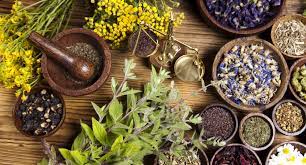If you’ve been trying to live the life of a committed yogi, like me, you’ll have discovered that maintaining an all-round balanced and healthy lifestyle is not as easy as it sounds. As we enter the cooler fall weather, and the coughs and colds start to reappear, it’s the perfect time to refocus on our general wellbeing.
A Brief Introduction to Āyurveda
A form of medicine that can help us restore balance is Āyurveda; an ancient, holistic branch of medicine, which uses a combination of dietary and lifestyle changes, herbal medicines and other treatments instead of a prescription from your GP. The goal of Āyurveda is to help banish aches, pains, sniffs and coughs and restore us to a state of physical, mental and emotional equilibrium.
Yoga and Āyurveda both originated as part of the greater system of Vedic knowledge inherited from the wise ones of India many thousands of years ago. They both work to address the root causes of imbalance, rather than patching over the symptoms.
Kate Siraj is the founder of The Āyurveda Practice, based in London, and she has a wealth of knowledge about how to live a balanced and healthy life. With a thriving business to run and three young children thrown into the mix, she knows all about the pressures that we’re under to keep healthy as we go about our busy lives.
Zen Monkey: How did you first come across Āyurveda and what inspired you to study it?
Kate Siraj: At the time I was working in the corporate world and was already thinking that it wasn’t really satisfying and I didn’t have my heart in it, although it was good fun. I’d been studying Indian philosophy and meditating for a while, then I spoke to someone who had been studying it, and got really excited. Consequently, I went and bought a book called Perfect Health by Deepak Chopra, which made me feel that Āyurveda had all the answers. I was thinking of changing careers anyway, so it all seemed to fall into place.
ZM: You qualified as an Āyurvedic practitioner in 2012. What was the most challenging aspect of achieving this goal?
KS: The most challenging part of the degree was supporting myself financially while doing a full-time degree. But really the biggest challenge was that afterwards I had to do an internship of 500 hours in India. My first trip I went with my husband and my first child, and then I had another child, and another, so I scraped a few weeks here and there whenever I could!
ZM: The similarities between yoga and Āyurveda are intriguing. What yogic practices are involved in Āyurveda?
KS: There are various practices which are used interchangeably in both, like using neti pots or eye exercises like strengthening the eyes by looking at candles. Prānayāma (breathing techniques) and meditation are found in both systems and they’re practices that I’ll recommend to people.
ZM: Fundamental to Āyurveda are the three doshas. Can you explain this concept?
KS: The doshas are the mainstay of Āyurveda and are used on a daily basis as a diagnostic tool to work out our therapy. The doshas have developed over thousands of years of studying patterns present in different body types, and that’s why we look at our work through the lenses of the three doshas: vāta, pitta and kapha.
These elemental forces are in every cell of the physical and mental body and when they’re in balance it means that we are in health and when they go out of balance it means we are in disease.
ZM: In Āyurveda the diet is a crucial part of the practice. With three young children of your own, how do you manage to stick to your dietary principles?
KS: Fairly easily these days, but it was a different story when the children were young as I didn’t have any energy, never got any sleep and was surviving on nothing! Now it’s just part of how we live. In Āyurveda there are general dietary guidelines which suit everybody, so we all eat a very similar diet.
The main things are to cook fresh every day, so it’s all healthy, fresh food, and eat as seasonally as you can. We eat a moderate amount of meat or fish, with more vegetarian food because it’s easier to digest.
I also cook very simply, and I rarely make a meal that takes more than half an hour to make, and I only cook one meal for the whole family. It’s lots of steamed vegetables, lentils and other pulses, and change it up by using different spices.
ZM: Why do we experience cravings for unhealthy food – and how do we control them?
KS: We get cravings because we’re out of balance. Then we give in to the craving which creates a worse imbalance and it becomes a vicious cycle. Personally, I make it easier for myself by not having any refined sugar in the house. We have a very boring house in terms of food content! But it means that when you have the odd moment of weakness then at least 90% of the time you’re eating healthily.
A lot of the work is just to put a spanner in the wheel of that vicious cycle: getting people to suddenly make a change, through re-education and inspiration. This gets the wheels turning back in the right direction.
You can do that by really listening to your body, for example, waiting until we’re hungry before we eat. Rather than eating by the clock or because we’re feeling emotional, you should wait until you get that rumbling feeling that says your tummy is empty. If you only eat when you’re hungry, you’ll find that your body digests food so much better and eventually experiences fewer cravings.
We also get cravings because we haven’t included all six tastes in our meals. These are: sweet, salt, sour, bitter, astringent and pungent. You don’t have to have all of them in equal quantities, but just by making sure that there’s something of all of those flavours, you’ll then find you’re much more satisfied after you eat. The astringent taste’s often left out because not many people understand it, but that can be supplied with a herbal or rooibos tea, for example.
ZM: As the days get shorter and the nights draw in, can you give us some tips to help us fight off those seasonal bugs?
Autumn is when the dosha of vāta gets aggravated. The qualities of vāta are that it’s cold, light, dry, rough, moving and subtle. There’s an Āyurvedic principle, that ‘like increases like‘, so anything which is the same as those qualities is going to increase vāta, and anything which is opposite is going to decrease it.
By focusing on the opposite qualities to ground us in this season we can ward off vāta-related imbalances. For the fall it’s important to have a diet that is warm, oily, heavy, and has a grounded nature. Make sure you use good oils, seasonal vegetables, such as the sweet, root vegetables and add warming herbs and spices. You should also start the day with a mug of warm water, followed by a warm breakfast — such as porridge or stewed fruit — and keeping going through the day with warm herbal teas.
Autumn is also the time to have stillness and steadiness in your life, such as a routine of regular meditation, and then you’ll find you’re much stronger and can stay healthy through the winter. If you know you experience Seasonal Affective Disorder, then it’s a good idea to get all these principles in place now, while it’s still a bit sunny and you’ve got the energy to start implementing changes, rather than wait till later in the season when you haven’t got the energy to do anything about it.
ZM: Finally, what advice would you give to anyone wanting to follow their passion and turn it into a vocation?
KS: If it’s your passion, first of all make sure that it is something that you really love. It could be worth it to get some coaching, and really work out why it is that you love it, because once you’ve established that, there’s really nothing that can get in your way.
For me, what I really loved was being able to help people find their peace, so Āyurveda really fit with that. To keep me motivated I wrote it down, and have it stuck to my wall, because when times are tough and I’m asking myself, “Hang on, why am I doing this again?“, I come back to those initial reasons and am sustained again.
I feel I get huge benefits from doing something I love, and it’s mentally healthier too!













